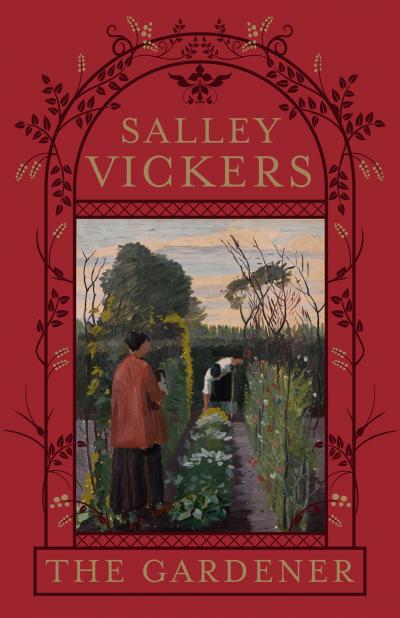A garden is a space defined by its limits. Whatever its contents in terms of style and species, and however manicured or apparently wild its appearance, what distinguishes a garden from its equivalent quantity of uncultivated land is its enclosure within an uninterrupted border, which might be a wall, a hedge, a fence, or else natural dividers such as streams or woodland.
The border creates the garden by shutting it off from the rest of the encroaching world. What is allowed to pass in and out of this bounded space is then up to a gardener: over this small portion of a chaotic planet, he or she can yield exquisite control.
In Salley Vickers’s eleventh novel, The Gardener, the garden is a powerful metaphor for the self, its paradoxical status as both cultivated and wild reflecting the two poles of discipline and indulgence between which we shuttle as we negotiate our emotional lives. It begins in 2018, when its protagonist Hassie (real name Halcyon) Days moves into a “sprawling” house on the “English side” of the Welsh Marches along with her sister Margot, who works in finance in London and insists upon gluten-free bread and non-dairy milk, though she is neither a cœliac nor a vegan. The sisters’ new home in the fictional village of Hope Wenlock is a modest Jacobean manor with a 1970s interior. Its grand name, Knight’s Fee, as Hassie later learns, is a “foolish gentrification” of the original Wight’s (man’s) Folly.
Hassie used to live in London, too, but when we meet her upon arrival in Hope Wenlock she is coming from Sheffield, where she spent the previous year caring for the ailing father whose death provided the deposit for the sisters’ new house. Her “flight” from Bethnal Green to Yorkshire, she later admits, was really only “under the cowardly cover of filial concern”. The real reason was to escape from Robert, the married art dealer she still loves, and from her terrible grief at his having left her. The house in Hope Wenlock, and its “extensive garden” in particular, stands “[i]n its decayed grandeur” for “a way of life which [Hassie] could never before have entertained.” Here, she feels sure, she will finally succeed in “wrench[ing] [her] life round into a new pattern, one in which Robert [is] no longer [her] sun and moon, the source of [her] light, [her] measure of the months and years.”
 We think we know where this story, whose dedication indicates that it was written during the quietude of England’s interminable 2020 lockdowns, must be going. “Getting over” the loss of someone we love by way of a dramatic change in lifestyle is a familiar pursuit, in theory if not in practice. But Hassie’s new surroundings bring little respite. The first half of The Gardener is very much like the long, hot summer of 2020, in that virtually nothing happens. Hassie’s persistent, unwanted feelings have her in a “stranglehold”. She disappears inside them like the plants in her new garden, which she discovers to be so “taken over” by bindweed and ground elder that their shapes are no longer discernible.
We think we know where this story, whose dedication indicates that it was written during the quietude of England’s interminable 2020 lockdowns, must be going. “Getting over” the loss of someone we love by way of a dramatic change in lifestyle is a familiar pursuit, in theory if not in practice. But Hassie’s new surroundings bring little respite. The first half of The Gardener is very much like the long, hot summer of 2020, in that virtually nothing happens. Hassie’s persistent, unwanted feelings have her in a “stranglehold”. She disappears inside them like the plants in her new garden, which she discovers to be so “taken over” by bindweed and ground elder that their shapes are no longer discernible.
The only way she has found to cope is to forbid herself from thinking about Robert. Any memory associated with him she walls off from her waking mind, rendering swathes of her emotional terrain untouchable. In the early days, an “almost physical shudder accompanie[s] the memory of a moment with Robert.” Words of love have become “exactly the kind of memory I didn’t want to be having.” The same goes for memories of her dead, beloved father, by whose image she is “suddenly assailed” on occasion, like a fortress resisting a marauding horde. Her only protection is emotional lockdown.
But as Vickers, who trained as a Jungian psychoanalyst, well knows, shutting ourselves off from the feelings that torment us is no way to go about conquering them. This is the lesson the garden and its eventual gardener teach Hassie by stealth over the course of The Gardener’s deceptively parochial plot. The novel is nested between two short letters to an initially unidentified addressee dated “March 2019”. In the first of these, Hassie writes that it was in the “old garden, where in a sense everything began, where I began to understand certain things and where I also began to understand that there were many more things that I would never understand.”
The garden’s lessons to this effect are strikingly literal. When Hassie first views the house, the planted borders around its formal garden promise shelter from the perils of the world that lies beyond. To house-proud Jacobeans, according to the National Trust, the regimented topiary typical of the favoured French style expressed “ultimate control over nature”. Virtually as soon as Hassie moves into Knight’s Fee, however, she discovers that its borders have already been breached. On one of her first ventures out into the garden after arriving, she happens upon “what must have been a nursery garden”, where on “rotting posts” hang “remnants of nets, once there to keep marauding birds from ripening fruit, now riddled with holes large enough for flocks to fly through.” “Rampant weeds” “invade” the flower beds, “vicious-looking nettles” “await” their victims and “evil yellow fungi” “bracelet” the trees.
Tidy garden, tidy mind. If “control over nature” equals control over ourselves, then it comes as no surprise, in this environment, that Hassie finds herself unable to hold back those unthinkable thoughts. Robert is suddenly everywhere. The sight of a “tiny snail with a translucent violet-and-yellow-striped-shell” reminds her of “other unnatural-seeming natural things”, which leads her to “mistletoe” and from there a “recollection of a stolen Christmas Eve with Robert”. This, predictably, is “exactly the kind of recollection that I was trying not to have.”
By forcing her to accept that she “can’t manage this” alone, Hassie’s unexpectedly wild garden also lays a path out for her into three close relationships, in a village where she was convinced she would find none. Phyllis Foot, the village matriarch, presents her with seeds and local folklore. Peter Haycroft, the widowed vicar whom she originally mistook for a church gardener she might employ, introduces her to the faintly mythic history of Knight’s Fee and its erstwhile owner Nelly Dean. Most important is Murat, the Albanian-born Corfiot expat who becomes the novel’s eponymous gardener after answering Hassie’s notice in the post office window. Murat shares Hassie’s disappointment in love but none of her terror in the face of the past. He remains on good terms with the wife who left him after he upended his life to come to Shropshire for her. Since finding Greek coffee at a shop in Ludlow, he hasn’t missed Corfu at all.
If all this is beginning to sound like a white woman’s Orientalist fantasy of a handsome stranger from the East who might teach her to love and live again, then it does so by design. Vickers is a writer far too attuned to the ways in which our desires and dreads distort our view of other people to make the rookie mistake of creating a protagonist who is capable of seeing other characters for who they really are. Murat’s name is a variant of the Arabic Murad, meaning “wanted’, “desired”, “wished for”, “intended”. But he is not the second-act romantic saviour that convention and form make us want him to be. In fact, despite its transparent title, The Gardener offers us very little information about the gardener at its centre.
If there is one theme that runs through all of Vickers' novels, it is that people are a great deal more complicated than they appear at first glanceThe Gardener’s stubborn refusal to let its reader into anyone’s psyche other than Hassie’s makes it a frustrating read at times. For all their apparently auspicious names – the obvious Halcyon and Haycroft, but also Phyllis and Peter from the Greek for “foliage” and “stone” – Hassie’s new friends, as it turns out, are “private people with their own private worlds”. They are not “the sort to probe” and they “[dislike] being probed.” Vickers takes a Dickensian delight in charactonym. Her own given name (the Irish for “willow”) her parents cribbed from Yeats’s “Down by the Salley Gardens” (1889). But Vickers’s playful character names hold none of the nominative determinism of those such as Pip and Estella in Dickens. If there is one theme that runs through all of her novels, it is that people are a great deal more complicated than they appear at first glance. The Gardener is an unusually gappy and opaque novel, because it refuses to turn the resources of narrative fiction towards pruning humans down into manageable characters. When Hassie asks Murat if he knows how to garden and he responds, “I read books, I learn”, is he assuring her agrammatically that he will learn how to garden? Or is he passive-aggressively highlighting a racist implication that he cannot read, cannot learn? Do we even know whether “read” is in the past or present tense? Vickers provides us with no further clues. She is not the sort to probe.
While I was reading The Gardener, I found myself reacting to it, like Hassie regarding her untameable garden, “with a mixture of awe and resentment”. Its rendering of character is frustratingly uneven and its narrative excursions into the past seem so randomly introduced that the pacing often feels wildly out-of-kilter. Viewed as a whole, though, the novel's narrative design emerges as instrumental to its central conviction, as set out in the prefacing letter: that “the certainties we construct are apt to be toppled by reality.” Try as we might to control it, nature has other ideas:
Foliage like fine green lace poised further blues from the self-seeded love-in-a-mist. The oriental poppies, bought at the garden centre, had spread their veined hairy leaves and the lupins and the foxgloves were pushing up tender-budded spires. Other perennials, from Nelly East’s time, were re-emerging… But happy as I was to see all this, what was most thrilling was the sight of the seeds Murat and I had sown germinating in the darkness of the potting shed.
Hassie hopes that the plants beneath the bindweeds will reveal themselves as flowers, but the only way to find out is to renounce the delusion that she can control the world around her. Perhaps, like the garden-centre poppies, the quotidian will grow to be wild and beautiful, and perhaps, like the hollyhocks, the long-lost past will return to us anew. Perhaps new love will seed itself, and germinate in darkness. The point – Vickers’s point – is that Hassie doesn’t know. We never do.
It is a novel whose ethical concern is inextricable from the context of the pandemic during which it was writtenIn 1625 Francis Bacon described gardens as “the purest of human pleasures”. At least a portion of every garden, according to his tract On Gardens, should be “framed, as much as may be, to a natural wildness… not in any order.” Despite its scant concern with the world outside Hope Wenlock, The Gardener’s deep ethical commitment to the “natural wildness” of people has profound political implications. It is a shame, I think, that Vickers chose to set it in 2019; I can imagine its events unfolding in the summer of last year with virtually no changes necessary other than masks on Hassie and Murat as they wander around the garden centre. The Gardener is a novel whose ethical concern is inextricable from the context of the pandemic during which it was written. Coronavirus restrictions over the past two years have had the unwelcome side-effect of lending an air of scientific sanction to a tendency in British life that has been growing ever since the global financial crisis of 2007-2008: retreating inside your own walls and battening down the hatches; communion with others as a concession to invasion; we must defend our borders, no matter the cost.
But the borders between ourselves and others are never as secure as we imagine them to be. People have an amazing knack of burrowing their way in. And life, in any case, is both far too big and far too beautiful for us to spend it locked down inside ourselves, no matter how safe a wall might enable us to feel. The Gardener is a story about allowing your defences to be breached. Relationships are worth embarking upon because – not in spite – of the awful, untameable wildness of other people. As Phyllis puts it to Hassie as she hands over a packet of forget-me-not seeds: “Sorry to give you more invaders,” but “they do fill the gaps” and they “keep down the weeds.”
- The Gardener by Salley Vickers (Viking, £16.99)
- More book reviews on theartsdesk















Add comment